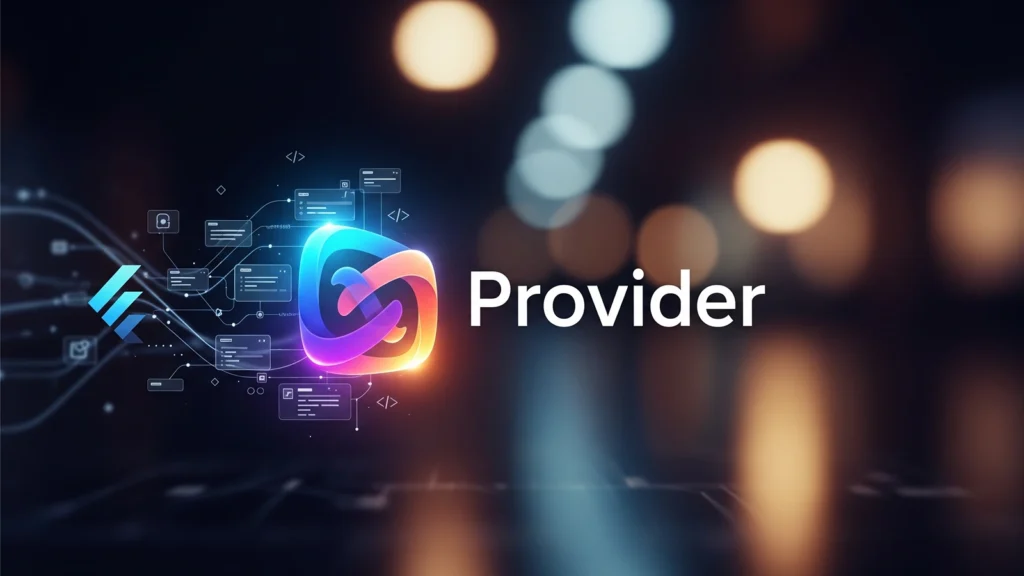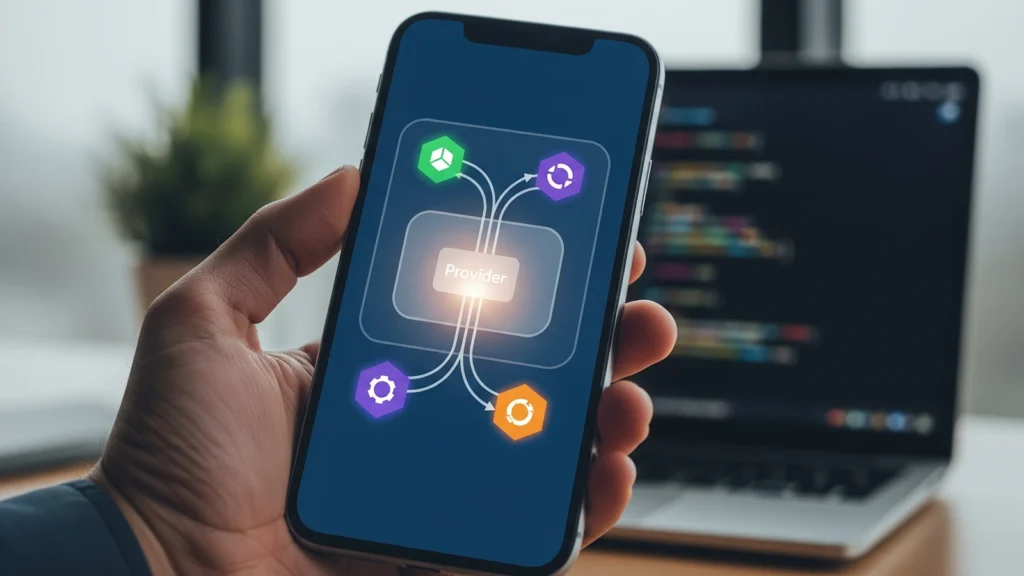
The Provider package is a powerful, simple, and popular state management solution for Flutter, highly recommended by the Flutter team. It acts as a wrapper around the fundamental Flutter concept of InheritedWidget, making it much easier to use, less verbose, and more efficient for managing and sharing application state. In essence, the Flutter Provider implements the concepts of Dependency Injection and State Management by making a piece of data (the “state” or a “service object”) available to all widgets below it in the widget tree, allowing those widgets to rebuild automatically when the data changes.
1. Core Concepts and Architecture
At its heart, Provider simplifies how you access and update data across your application.
1.1. The Problem Provider Solves
In a typical Flutter app, data is passed down the widget tree through constructors. For data that needs to be accessed by deeply nested widgets, this leads to “prop drilling”, passing the same data through many intermediary widgets that don’t actually need it. Flutter Provider solves this by using the InheritedWidget mechanism. An InheritedWidget holds data and is placed high up in the tree. Any descendant widget can easily “look up” and access that data using the widget’s BuildContext without needing to pass it through every layer. Provider abstracts this complex mechanism into a simple, clean API.
1.2. Key Components
There are three main concepts to understand when using Provider for state management:
| Component | Role | Description |
| ChangeNotifier | The Model/State | A class mixin or abstract class that holds your application data and business logic. It has a notifyListeners() method, which you call to tell all listening widgets that the data has changed. |
| ChangeNotifierProvider | The Provider | A widget that wraps your ChangeNotifier and places an instance of it into the widget tree. This makes the state object accessible to its descendants. It’s often placed high up, usually around MaterialApp or at the screen level. |
| Consumer, context.watch(), context.read() | The Consumers | These are the ways widgets in the application access the provided state object. |
2. Accessing the State (The Consumers)

Widgets access the data provided by a Provider in three main ways, each suited for a different scenario.
A. context.watch<T>() (The Listener)
- When to use: In the build method of a widget that needs to rebuild when the state changes.
- What it does: It subscribes the calling widget to the Provider’s changes. If the data in the Provider changes and notifyListeners() is called, the widget’s build method will automatically rerun.
B. Consumer<T> (The Dedicated Listener)
- When to use: When you only need to rebuild a small part of a larger widget’s build method. This is an optimization tool.
- What it does: The Consumer widget only rebuilds itself and its immediate children when the state changes, isolating the rebuild area for better performance. It takes a builder function that provides the state object.
C. context.read<T>() (The One-Time Read)
- When to use: When you need to access the Provider’s data or call a method on it, but you do not need the widget to rebuild when the data changes. Common for triggering events like button presses or fetching initial data in initState.
- What it does: It returns the Provider’s value without subscribing the widget to changes. You must use this method within callbacks or lifecycle methods (such as initState, didChangeDependencies, or event handlers like onPressed).
3. Different Types of Providers
While ChangeNotifierProvider is the most common for complex application state, the package offers other specialized providers for various data sources:
| Provider Class | Purpose | When to Use |
| Provider<T> | Basic Dependency Injection | For objects that never change or don’t need to notify listeners (e.g., utility classes, services, or repository instances). |
| ChangeNotifierProvider<T> | Reactive State Management | For classes that extend or mix in ChangeNotifier and need to notify listening widgets when data changes. (This is your everyday state management tool.) |
| FutureProvider<T> | Asynchronous Data (Single Value) | When you need to provide a value that will be loaded at a later time (e.g., a single API call result). It provides an initial value until the Future completes. |
| StreamProvider<T> | Asynchronous Data (Multiple Values) | When you need to provide values that arrive over time (e.g., real-time updates from a database or a stream of events). |
| MultiProvider | Combining Providers | To register multiple providers at one level in the widget tree, avoiding deeply nested provider structures. |
| ProxyProvider<T, R> | Dependent Providers | To create a provider that depends on the value of one or more other providers (e.g., a ViewModel that needs an instance of an APIService provided by another provider). |
4. Basic Implementation Steps

1. Add Dependency
In your pubspec.yaml, add the provider package and install it:
| Dependencies: provider: ^latest_versionThen run:flutter pub get |
2. Create a State/Model Class
Define a class to hold your app’s data and logic. Make it extend ChangeNotifier so that UI widgets can react to changes.
| class CounterModel with ChangeNotifier { int _count = 0; int get count => _count; void increment() { _count++; notifyListeners(); // Notifies listeners to rebuild the UI }} |
3. Provide the State
Wrap your app (or the part of the widget tree that needs access) with a ChangeNotifierProvider.
| void main() { runApp( ChangeNotifierProvider( create: (context) => CounterModel(), child: MyApp(), // MyApp and its descendants can now access CounterModel ), );} |
4. Consume the State
Use the provider inside widgets to either read data or trigger actions:
- To display the value (rebuilds on change):
Text(‘${context.watch<CounterModel>().count}’)
- To call a method (no rebuild required):
| ElevatedButton( onPressed: () => context.read<CounterModel>().increment(), child: const Text(‘Increment’),) |
Frequently Asked Questions (FAQ)
What is the difference between context.watch(), context.read(), and Consumer?
- Watch (): Used inside the build method. It subscribes the entire calling widget to changes, causing a complete widget rebuild on state change.
- Read (): Used outside the build method (e.g., in onPressed or initState). It accesses the value once without subscribing, preventing unnecessary rebuilds.
- Consumer: Used inside the build method. It acts as an optimization wrapper, allowing you to wrap only the specific widgets that need to be rebuilt, thereby minimizing the rebuild scope.
When should I use Provider.of instead of context.watch() or context.read()?
Provider<T>(context) is the older API.
- To listen and rebuild, use Provider.of<T>(context, listen: true) (equivalent to context.watch()).
- To read only, use Provider.of<T>(context, listen: false) (equivalent to context.read()).
It is generally recommended to use the extension methods (context.watch() and context.read()) as they are shorter and cleaner.
How do I handle multiple providers at the root of my app?
Use the MultiProvider widget. This prevents the “Christmas tree” effect of deeply nested providers, keeping your code organized.
| MultiProvider( providers: [ ChangeNotifierProvider(create: (_) => UserProvider()), ChangeNotifierProvider(create: (_) => SettingsProvider()), // … any other providers ], child: const MyApp(),); |
Does Provider automatically dispose of my ChangeNotifier?
Yes, if you create the provider using the standard create: (context) => MyModel(), the Provider will call the dispose() method on your ChangeNotifier when the Provider widget is removed from the tree. This helps prevent memory leaks. However, if you use the .value constructor (e.g., ChangeNotifierProvider.value(value: existingModel)), Provider will not call dispose() because it assumes you are managing the lifecycle of that existing object yourself.
Can I use Provider with FutureBuilder or StreamBuilder?
It is generally better to use FutureProvider or StreamProvider instead. These dedicated provider types handle the boilerplate of tracking connection state, data, and errors that you would otherwise have to manage manually with FutureBuilder or StreamBuilder inside your consuming widgets.
Conclusion
The Provider package is an outstanding choice for state management in Flutter, bridging the gap between the low-level complexity of InheritedWidget and the need for a simple, scalable solution. By following the principles of ChangeNotifier (the logic), Provider (the locator), and Consumer (the listener), you can achieve a clear separation of concerns, resulting in applications that are highly performant, easier to test, and significantly more maintainable. Whether you are building a small personal project or a large-scale enterprise application, Provider offers an efficient, well-supported, and elegant approach to managing your application state.
